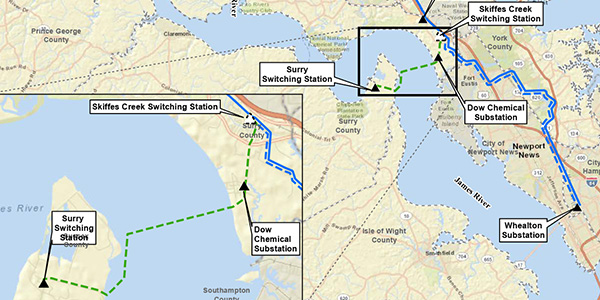By Christen Smith
A three-judge D.C. Circuit Court of Appeals panel said last week the Surry-Skiffes Creek transmission line in Virginia can remain operational — for now — while the legal battle over the U.S. Army Corps of Engineers’ permit for the $400 million project ensues in a lower court, where judges could ultimately force Dominion Energy to tear it down.
In March, the panel said the corps violated the National Environmental Policy Act by not issuing an environmental impact statement (EIS) and vacated the permit for the project, which crosses the James River and passes in close proximity to several historic parks and trails “dating back to the birth of our nation.”
In an appeal, the corps and Dominion did not dispute that the permit was illegal, but they requested the court remand the project back to the corps without vacating the permit, saying the court did not “have before it the recent factual developments regarding completion of construction and the disruption that vacating the permit could cause.”
“That, of course, is because neither petitioner bothered to advise us that construction on the project had been completed and the transmission lines electrified the week before we issued our opinion,” the judges said in their March 31 decision.
The National Parks Conservation Council and National Trust for Historic Preservation had originally appealed the permit in the D.C. District Court. Opponents have contended the line will ruin the view at Jamestown and other nearby historic sites, dismissing as a scare tactic Dominion’s warning that failure to build will result in blackouts in Virginia’s middle peninsula. (See Opposition to Va. Tx Line May Trigger Unintended Consequences.)
The corps and Dominion argued the permit should stand and the 500-kV line should stay in service to maintain reliability and provide power to the 600,000 residents on Virginia’s peninsula. PJM first greenlit the project in 2012 as the best solution to fill the gap left behind by the retirement of two coal-fired plants in Yorktown deemed incapable of meeting federal emissions standards. Dominion electrified the line in February and wants to keep it operational while the corps conducts the court-ordered EIS, slated to take at least a year to complete.
The D.C. Circuit remanded the case back to the district court to decide whether the request is even feasible. It admonished the utility company and the corps for not notifying it that the project was finished before it made its decision.
“Had the corps and Dominion said all along what they say now, either the district court or this court might have enjoined tower construction, in which case our consideration of ‘disruptive consequences’ … would focus not on shutting down and removing the towers, but rather on prohibiting their construction — a very different balance indeed,” the panel said. “Moreover, having completed construction, petitioners now attempt to use it to place an even heavier thumb on the scale.”
The plaintiffs argued that by not disclosing that the project was operational before the court made its decision, the corps and Dominion had waived their right to argue that vacating the permit would be too disruptive. They noted that to defeat their motion to prevent construction, the corps and Dominion had assured the lower court if it required the corps to issue an EIS, the project could be dismantled without a problem. The circuit court said this was “more than a little troubling.”
However, “we nonetheless believe the best course of action is to remand the case to the district court to consider … whether vacatur remains the appropriate remedy, including whether [the corps and Dominion] have forfeited or are judicially estopped from now opposing vacatur,” the D.C. Circuit said. “That court is best positioned to order additional briefing, gather evidence, make factual findings and determine the remedies necessary to protect the purpose and integrity of the EIS process.”
Paul Edmondson, interim president and CEO for the Nation Trust for Historic Preservation, applauded the ruling in a statement last week, noting the decision underlines “the historic significance of the James River.”
“There are feasible alternatives to this transmission line, but there’s only one Jamestown,” he said. “With vast resources at its disposal, Dominion should do the right thing by deconstructing these towers and working to provide reliable power in a way that does not come at the expense of America’s birthplace.”
Analysts with ClearView Energy Partners believe the lower court — or the results of the EIS — could indeed force Dominion to dismantle the project and reroute it, spawning a cascade of possible service disruptions and reliability concerns. On a broader scale, analysts warn the project’s outcome sets a precedent for what happens when federal agencies do not follow statutes and regulations, ultimately increasing the risks for transmission project developers.


